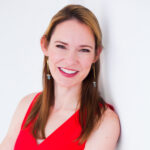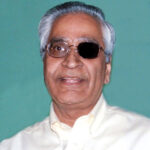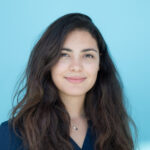Taking a Look at Optics
Taking a Look at Optics
We asked three alumni who graduated in different generations to provide their perspectives on optics, education, and the future.

Alexis Vogt ’00, ’08 (PHD)
Alexis Vogt is the endowed chair and professor of optics for the Optical Systems Technology program at Monroe Community College in Rochester, N.Y. This is the nation’s only two-year degree program that trains technicians for work in the precision optics industry.

Bala Manian ’69
Bala Manian is an Indian-born Silicon Valley entrepreneur and a University life trustee. Career highlights include developing the first laser scanner for the supermarket industry, earning an Academy Award certificate for technical achievement in the film industry, and creating medical testing and instrumentation technology and products.

Cherine Ghazouani ’21
A native of Tunisia, Cherine Ghazouani is an optical design engineer at ASML, a semiconductor company in Connecticut. In college, she was a Student Alumni Ambassador, a peer advisor, an Ain Center for Entrepreneurship and Innovation ambassador, and the recipient of an Alan and Jane Handler Scholarship, which is awarded to students based on their financial need, exceptional academic talent, and outstanding leadership potential
The study of light has a profound impact on everyday life, especially for these three Institute of Optics alumni
Optics is all about light: how it’s propagated, generated, and detected. It’s small, it’s lightweight, and nothing in the world moves faster. It plays a central role in our daily lives, too, without most of us knowing it.
The applications are vast—from entertainment to science to medicine and beyond—and its impact is huge. But meeting the growing demand for optics professionals is a challenge. “Because nearly everything is powered by optics, the field is growing at an incredible rate,” says Tom Brown, director of the University’s Institute of Optics and the Mercer Brugler Distinguished Teaching Professor. “And, right now, there just aren’t enough knowledgeable, skilled, and trained scholars, researchers, engineers, and technicians out there. We—and the world—need more of them.”
A recent gift from University of Rochester life trustee James C. Wyant ’67 (MS), ’69 (PhD), ’21 (Honorary) and his wife, Tammy Wyant, will help meet this demand. This fall, the couple established a $12 million, 10-year professorship challenge that will help the institute increase its faculty by 50 percent, graduate the next generation of optics professionals, and help the institute grow its preeminent status.
What fascinates you about optics?
CG: It’s everywhere. Many people assume I’m an optician or that I do something related to eye glasses. I want people to know that optics is all this and more. My work actually has to do with the semiconductor industry, a field that has broad applications related to energy, manufacturing, transportation, and medicine. There’s so much potential with optics because, look around, everything is based on light and visuals. The challenge is to maximize practically unlimited potential. Think about it: optics plays a key role in everything from building self-driving cars to studying and understanding diseases to creating clean water systems for developing countries.
BM: Its broad application. When I came to the Institute of Optics in 1967, I was excited to see how optics was at the foundation and the intersection of many fields. As a graduate student, I was part of an ecosystem that inspired us to make a difference, to become entrepreneurs, and to solve real world problems. I was in a very distinctive cohort.
AV: Its potential. When I joined MCC six years ago, the optical technology program had just five students. Today, we have 115. The program is growing but doesn’t graduate enough students to meet the regional and global demand for highly skilled optics technicians. I encourage anyone who is curious about our program to look into it. It attracts all types. For instance, I was at a fundraiser recently and met a DJ who is also an auto mechanic and a woodworker. I told him about this program, he came for a tour, and now he is enrolled as a student.
Favorite optics class?
CG: Optics 101 with Professor Tom Brown. Within a few weeks, I was all in—drawn to the field, the faculty, the institute, my cohort, everything. I also really enjoyed my geometric optics class with Professor Julie Bentley—she’s an icon in the field, a lens design expert, and a role model for all, especially for women in science, technology, engineering, and mathematics (STEM).
BM: Professor Bob Hopkins’ optics design courses 240 and 241. Those classes showed me that what I was learning could immediately relate to something practical. Professor Hopkins became my role model and mentor.
AV: My first introductory optics class with Professor Turan Erdogan. He is the reason I am in this career. He had this remarkable way of distilling complex topics down in a way that I understood and that inspired me.
Pivotal college experience?
CG: There are many, including being a Handler Scholar. I wouldn’t have been able to attend the University without it—I owe so much to the Handler community. I’m also very proud of my involvement with Industrial Associates, an all-day event in the fall and spring that immerses students in research, lectures, and discussions with optics professionals as well as a career fair. It’s all come full circle, too—I got my first internship from an IA event, and today I work for that company, and I attend IA events as a recruiter.
BM: I don’t have just one. The whole experience as a graduate student and then later as an assistant professor and manager of an optical fabrication and testing facility at the institute were important parts of my professional development. Each step in my education and career helped lead to the next one.
AV: I did an honors research project with Dr. Tom Foster at the Medical Center, which showed me how much optics can do to serve the medical industry. I also had two summer internships at Corning. And, my PhD work with Professor Tom Brown was instrumental in laying the foundation for my career. These experiences introduced me to faculty, peers, business professionals, and friends with whom I still interact regularly.
What would surprise people to know about you?
CG: A lot of people tell me I don’t “look North African.” I want to break down stereotypes like this, especially as a woman in science from a developing country. It also surprises people to know I speak four languages. In Tunisia, we all learn Arabic, French, and English. I also taught myself Turkish by watching television.
BM: Many people are surprised by my activity in optics because I have only one eye. I lost my left eye in an accident when I was three years old. More often than not, people assume I had an accident with an optical laser, but that is not the case.
AV: I’ve played the violin since I was 5 years old. I was part of a number of musical groups in college and, up until the pandemic, still played in one of those ensembles. Another thing that surprises people: I have Pi memorized up to 82 digits.
What did you want to be when you grew up?
CG: When I was in middle school, I saw the movie Iron Man. I wanted to have a helmet and a lab just like Tony Stark’s, the lead character. As an optics professional, I’ve gotten pretty close to realizing that dream. A lot of my peers were inspired by that movie, too.
BM: My father was in business, and I knew from a young age that I wanted to be an entrepreneur. I still do. At 77 years old, I continue to work, and I don’t plan to retire. I love what I do.
AV: A kindergarten teacher. Teaching has always interested me, which is why I’m doing what I do today.
Proudest achievement?
CG: Graduating from the Institute of Optics. I made it through the pandemic with a degree in optical engineering from of the best—if not the best—schools in the world for it.
BM: Many people assume my proudest achievement is earning an Academy Certificate from the Academy of Motion Picture Arts and Sciences in 1999. I received that for developing the optical technology that made special effects possible in such movies as Return of the Jedi and Indiana Jones. Although that was a great honor, I have made the maximum contribution at the intersection between optics and life sciences. For instance, my companies developed the first laser film image recorder for medical imaging, protein and DNA analysis instrumentation, cell and gene therapy products, and blood-testing technology for AIDS and cancer patients.
AV: My family. My husband and three kids inspire me every day. So does my brother, Joe Spilman, who took my lead and graduated from the institute in 2003. Today, he’s the president of Optimax, a local optics company. Professionally, I’m proud of the students at MCC. It’s incredibly rewarding to see them thrive. Many of them have changed their lives through this program.
What motivates you?
CG: I love challenges and being in a fast-paced environment, and I want to be an entrepreneur someday. Today, I get to walk in the footsteps of the institute’s legends, which is incredibly inspiring.
BM: I get excited about solving problems. I often tell people that you go to school to learn how to learn. Once you’ve learned that, there is no science and no challenge beyond your capabilities.
AV: Knowing that the program at MCC can change lives, benefit our community, and affect the industry overall. It’s inspiring to get calls from local businesses and from Google, Microsoft, and Amazon alike—they all want and need our graduates. The Rochester area has been, and continues to be, such a great place for optics.
Did you know?
Optics is at the core of many products, services, and technologies, including:
Smartphones
Cameras and telescopes
Remote controls and televisions
Streaming services
Self-driving cars
LED light bulbs
Traffic lights
Barcode scanners
Surgical devices
Medical diagnostics and treatments
Learn about the Wyant Optics Challenge
Find out more about entrepreneurship
Explore the Institute of Optics
This story originally appeared in the fall 2022 issue of the Buzz.
— Kristine Kappel Thompson, November 2022


